How to handle laboratory waste at CBH campus Solna – Environmental Physiology
PROCEDURE
Decisionmaker: Head of School
Valid from: 7 October 2019
Changed from: 7 Ocotber 2019
Reference number: C-2019-0872
Responsible for review and questions: Infrastructure Manager
1. Purpose
To describe how to handle the chemical and hazardous waste at Environmental Physiology.
2. Scope
The routine covers all areas used by CBH in the Physiology building at Berzelius väg 13. KTH Environmental Physiology complies with KI's regulatory framework.
3. Definitions
Residues of chemicals with hazard labeling are classified as hazardous waste.
4. Responsibilities
- The Head of the School of Engineering Sciences in Chemistry, Biotechnology, and Health (CBH)is responsible for waste management and operating within the limits of his areas of responsibility.
- Infrastructure manager is a support in the work and report to the sustainability manager in response to the management's review of data collection on waste management and its processes.
- All employees working in lab are responsible for handling waste according to established routines and binding requirements
- Lab coordinator is responsible for that hazardous waste containers and labels are available in the labs.
- The person responsible for chemicalsis responsible for updating the chemical register, KLARA, when a chemical is purchased or discarded.
5. Procedure
NOTE: Discharge of any chemical waste to the drains is not permitted.
Bins for laboratory waste
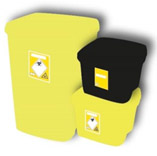
- Yellow plastic bins – is used for cutting / stabbing / chemical / infectious waste and drug waste.
- Black plastic bins – is intended for biological waste.
Both types of boxes are classified as dangerous goods when transported on public road which places high demands on safe transport to the destruction plant.
General instructions for the use of boxes:
- If the box is to be filled with liquid waste, the absorbent cloth should be placed in the bottom.
- The box must not weigh more than 12 kg. NOTE! Do not fill more than so that the lid can easily be sealed.
- Close the box carefully. The outside surface of the box should be clean.
- The box should be labeled with a fully completed label.
- When the box is filled and labeled, leave the box in the lab and tell the lab coordinator or the person responsible for chemicals where to find it. They will ensure that the box is sent away the proper way.
Sharps and infectious waste
Sharp products and needles
This includes all sharp objects such as needles, cannulas, scalpel, lancets, suture needles and glass slides, which must be placed in a small yellow box. When filled this box must be placed in a regular yellow bin.
Infectious waste
Human blood and blood products, microorganisms, cell cultures and materials that come into contact with them include gloves, pipettes, pipette tips, petri dishes, napkins and the like. This also applies when the waste is contaminated with minor amounts of drugs or chemicals.
Infected solid waste should be collected in yellow bins. Liquid waste that is infected should be collected in a tight-sealing bottle/can and then placed in yellow bins. The bottle/can/box must be labelled with a fully completed “SKÄRANDE/STICKANDE/SMITTFÖRANDE AVFALL” label (see below).

NOTE: Mixed waste of antibiotics/cytostatics/chemicals/ infectious agents can always be handled as Sharp/infectious waste.
Biological waste
- Biological waste must be placed in black boxes.
- Absorbents should be placed in the bottom of the box.
- The bottle/can/box must be labelled with a fully completed “BIOLOGISKT AVFALL” label (see below).
- For ethical reasons, biological waste must be handled separate from other waste.
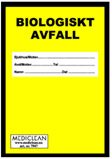
Chemical waste
- Chemicals labeled with hazard symbol, including reagent solutions, solvents, oils, colors, adhesives, disinfectants etc.
- Materials, such as gloves, paper towels and test tubes, contaminated with chemicals labeled with "Toxic", "Health Hazard" and / or "Dangerous" Hazard Symbols.
- Bottles and cans labeled with "Toxic", "Health Hazard" or "Dangerous" symbol. This also applies to empty containers.
- Some items containing environmentally hazardous metals, for example mercury thermometers.
- Unidentified chemicals (labeled "Unknown Chemicals" under "Content").
NOTE: Dilution of chemicals to negligible concentration or removal of chemicals via evaporation is not allowed.
General rules for handling chemical waste:
Liquid chemical waste
The bottle/can must not be affected by the contents. For liquid chemical waste, choose original packaging or appropriate UN-labeled container approved for transport of dangerous goods.
Example:
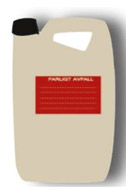
The container must be sealed properly with an intact lid.
Some liquid chemicals can be mixed, verify this before you combine them by reading the Safety Data Sheets.
The container should be labeled with content, hazard pictogram, date, dispatcher.
Material contaminated with chemicals labeled with "Toxic", "Health Hazard" or "Dangerous" symbol should be packed in plastic bags and then thrown in yellow boxes.
Containers containing permissible chemicals (A/B rated) shall be labeled with the chemical name and that it is a chemical subject to authorization.
Solid chemical waste
This type of waste can be disposed of in its original packaging or other suitable material – preferably the same type of material that the chemical was originally stored in. Never mix chemicals of different types. The container must be properly sealed.
Use the label “KEM AVFALL” directly on the container. The container must be marked with the content, date, dispatcher. If the container has the original markings indicating the correct content, only the dispatcher’s name need to be filled in.
If you are getting rid of larger amount of chemicals, you may put the containers in a yellow waste bin or cardboard box. The bin/box must be labelled with a fully completed “KEM AVFALL” label.
Chemical Waste Mixed with Contaminated Consumables and Sharps
Chemical Material, sharps and consumables contaminated with chemicals labelled with the symbol for “Highly toxic”, “Carcinogenic/Mutagenic” and/or “Environmentally toxic” must be either:
- Placed in plastic bags and then put into a yellow waste bin (if there is risk of fumes/exposure if the bin is not in a ventilated location). When full, use the label “Kem Avfall”. Fill in all the fields.
- Put in a cardboard waste box (with an inner thick black plastic waste bag). All sharps should first go into a sharps container, and then put into the cardboard box.
Pharmaceutical waste, including cytostatic waste
NOTE: Medicine from the Pharmacy (Apoteket) - submit any remaining medicine back to Apoteket.
Pharmaceutical waste includes antibiotics, hormone preparations and cytostatics, vaccines, narcotic drugs and objects that come into contact with these materials, for example packaging that contained antibiotics, cytostatics or other pharmaceuticals.
Note that needles and other sharp waste must be handled as sharp and infectious waste.
NOTE: Pharmaceuticals and cytostatics can pose an environmental risks if incorrectly handled. These substances are often slow to degrade and can be biologically active for a long time after use. They can also be highly toxic, induce mutations or cause hormonal disruptions.
- Waste that has been contaminated with cytostatics and other pharmaceuticals must first be placed in a sealed inner packaging (sealed plastic bag or similar) before being placed in a yellow box with other pharmaceutical waste.
- Liquid pharmaceutical waste must be collected first in leak-proof, sealable bottles/cans and then placed in a yellow bin.
- The bottle/can/box must be labelled with a fully completed “CYTOSTATIKA OCH LÄKEMDELSFÖRORENAT AVFALL” label (see below).
NOTE: The label for “Pharmaceuticals, including cytostatic” consists of two labels; the hazard symbol for “Highly toxic” together with the hazard symbol for “Environmentally toxic”.
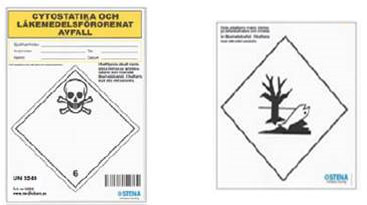
Empty bottles/cans
Bottles and cans that contain residues or are contaminated with chemicals that entail risks for health or environment shall be handled as “Chemical waste”. Bottles and cans labelled with the hazard symbols “Highly toxic”, “Carcinogenic/Mutagenic” and/or “Environmentally toxic” must always be handled as “Chemical waste” also when empty. Normal recycling centers will not accept packaging with such labels.
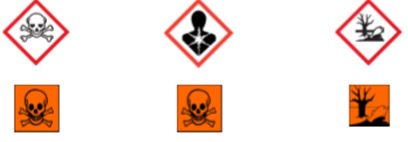
Clean packaging that do not have the above hazard symbols shall be handled as normal waste, i.e. sorted as glass, hard plastics, etc. – but only if it does not contain residues, dust or droplets! Sealed packaging that has contained flammable goods must be opened and rinsed carefully with water to prevent the contents giving off flammable vapor after the packaging is placed in the source sorting bins. The packaging shall be discarded without a lid to further minimize the risk of fire.
In cases of doubt, the packaging shall be handled as chemical waste.
There is a detailed sorting guide, which is posted on KI:s intranet: Laboratory waste .
Hazardous waste collection
Hazardous waste is collected by STENA from the site, STENA is contacted when a pick-up is needed. At pick-up the personnel from STENA is responsible for writing a Transportdokument”, the personnel at “MTH, Solna” who have called for pick-up is responsible for signing the document, take a copy and give the copy to Björn Johannesson who is responsible for archiving these documents.
6. Attachments
None.
7. Amendments
| Approved version | Document Date | Amendment | Name |
|---|---|---|---|
| 01 | 2018-04-03 | New routine | Björn Johannesson |
| 02 | 2018-06-03 | Information regarding handling of the Transport document | Kicki Holmberg |
| 03 | 2019-04-16 | Routine moved to a new format. Revision of routine due to a new organization of the environmental management system, in which the environmental representatives’ role is replaced by responsible functions. This document replaces MR-CBH-010. | Sara Pettersson |
